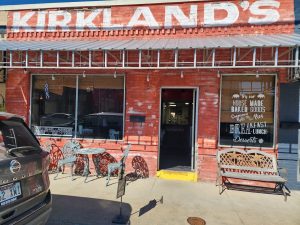New Madrid Earthquakes of 1811-1812

The first in a series of major earthquakes occurred on December 16, 1811, at about 2:15 a.m. near present-day Blytheville, Arkansas. Estimated at magnitude (M) 7.7, this event awakened people across much of what is now the eastern United States, up to about 900 miles away, including President James Madison in Washington, D.C. There were several large aftershocks that day, including the largest “Dawn” aftershock at about 7:15 a.m., estimated at M6.8–7.0.
The maiden voyage of the first steamboat on the Mississippi River, the New Orleans, began in September 1811 on the Ohio River at Pittsburgh, Pennsylvania. It reached the Mississippi River the week before the December 16 earthquake. One morning the passengers woke to find that the island they had moored to the night before had disappeared because of liquefaction due to frequent earthquake shaking.
According to reports of boat captains and others on the Mississippi River in December 1811, the earthquakes caused the river to fill with debris as the tree-covered river banks caved into the river. Other reports said the river flooded large tracks of land, created temporary waterfalls, and even ran backwards in some places. Today, similar bank failure, flooding, and river debris would affect bridge abutments, farm land and industries along the river, and barge traffic.
The second of the three major earthquakes, estimated at M7.5, occurred on January 23, 1812, at about 9:15 a.m. Similar to the December 1811 earthquake, this event was also widely felt throughout the region. Damage occurred in an area of about 232,000 square miles.
In 1811, the population of what is now the central United States was very sparse. Still considered to be the western frontier, there were only about 5,700 people in the St. Louis area at the time. Most historical reports (journals, letters, and newspapers) describing the earthquake shaking and its effects were written by people who were located east of the Mississippi River. Today, about 11–12 million people live in the St. Louis–Memphis region.
The New Madrid earthquakes caused extensive landsliding along about 125 miles of the bluffs on the east side of the Mississippi River north of Memphis. A repeat of these earthquake-triggered landslides today would affect eastern access to the Mississippi River, pipelines, and transmission towers located in this area.
The third and probably the most widely felt of the three major New Madrid earthquakes occurred on February 7, 1812, at about 3:00 a.m. There were several destructive shocks that day, the last and largest estimated at M7.7. As a result, the town of New Madrid, Missouri, was severely damaged.
Dr. Daniel Drake, a physician in Cincinnati, Ohio, kept a detailed account of the New Madrid earthquake sequence and cataloged thousands of earthquakes. He reportedly used a pendulum-type seismograph that “marked the direction of undulation from south-southwest to north-northeast.”
Important surface-deformation features caused by the 1811–1812 earthquakes are the Reelfoot fault scarp (an uplift of the land surface above the fault); Reelfoot Lake in western Tennessee; a large sand-blow liquefaction field in Arkansas, Missouri, and Tennessee; and the Big Lake and St. Francis sunken lands in northeastern Arkansas. The New Madrid earthquakes covered the region with sand blows, thousands of which remain today and can be seen as large, light-colored sandy patches in agricultural fields.
As a result of land subsidence and uplift from the February 7, 1812, earthquake, water from the Mississippi River flooded the area and formed Reelfoot Lake. This event added to reports of the Mississippi River flowing backwards.
By March 15, 1812, an estimated 2,000 aftershocks had been felt, but it is likely that tens of thousands more were not felt or otherwise noted. At the time, many people were afraid to enter their homes for fear they would collapse. Damage from the largest of these shocks was reported from as far as about 300 miles away. Today, a robust aftershock sequence like this would impede rescue and rebuilding efforts throughout the region.
Research indicates that the 1811–1812 New Madrid earthquake sequence was preceded by at least two similar earthquake sequences in about 1450 AD and 900 AD, and that over the past 5,000 years or so, other large earthquakes have also occurred in the region surrounding the main area of the currently active New Madrid seismic zone.
There is a 7–10% chance or probability that a quake of magnitude 7.0 or greater will occur in the New Madrid region within the next 50 years. The probability of a quake of magnitude 6.0 or greater occurring during the same time period is somewhere between 28 and 46%.






